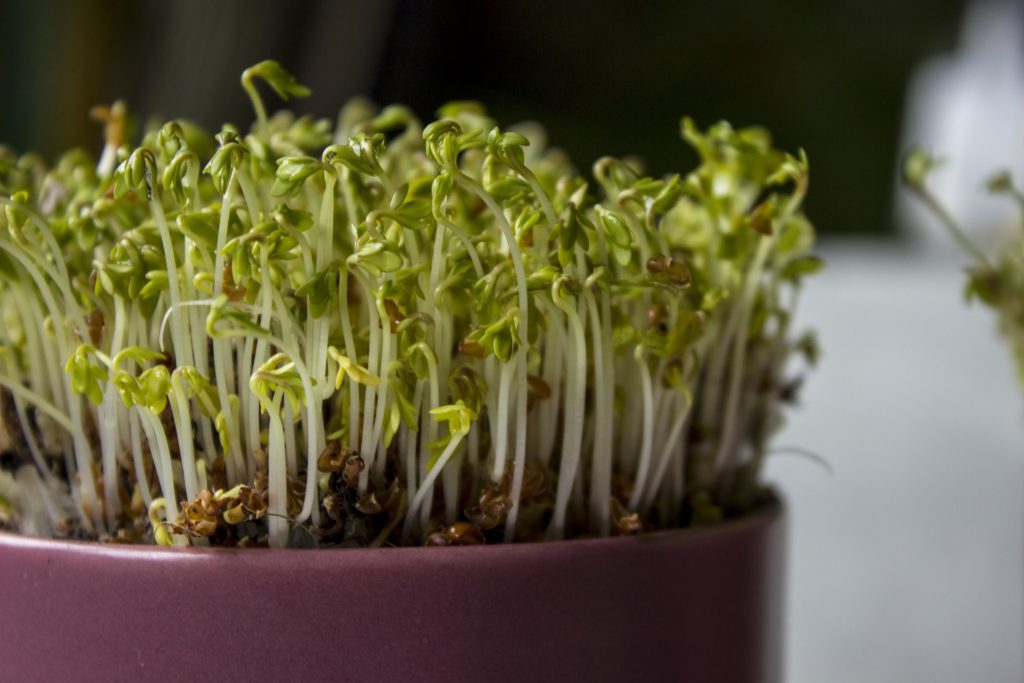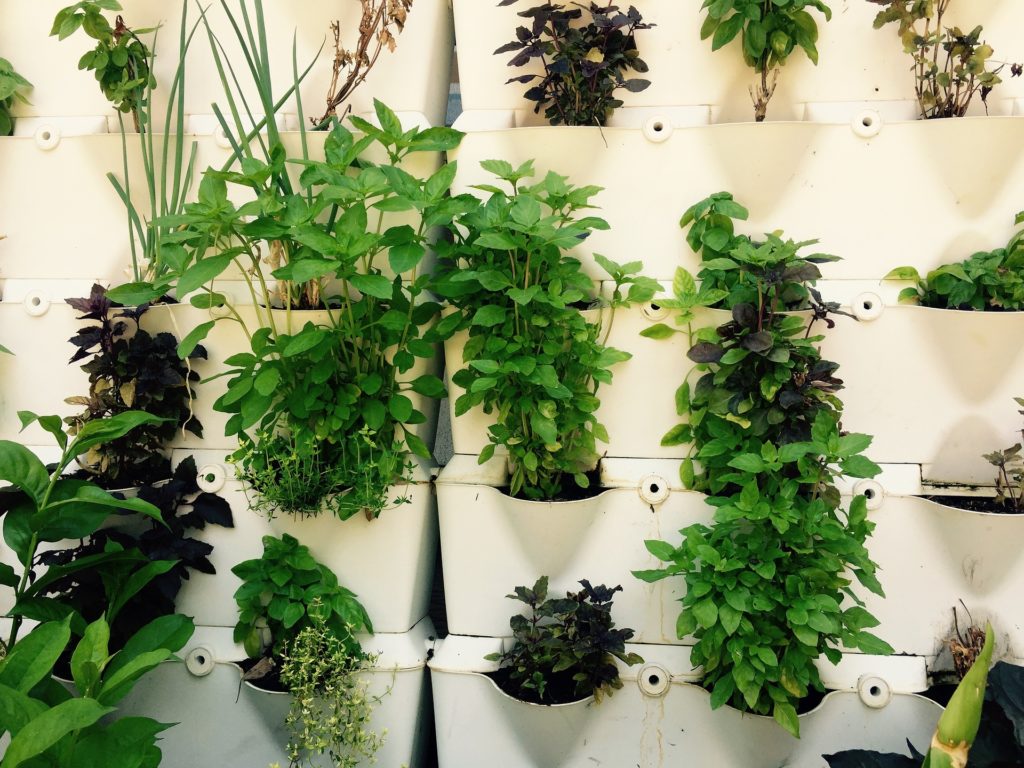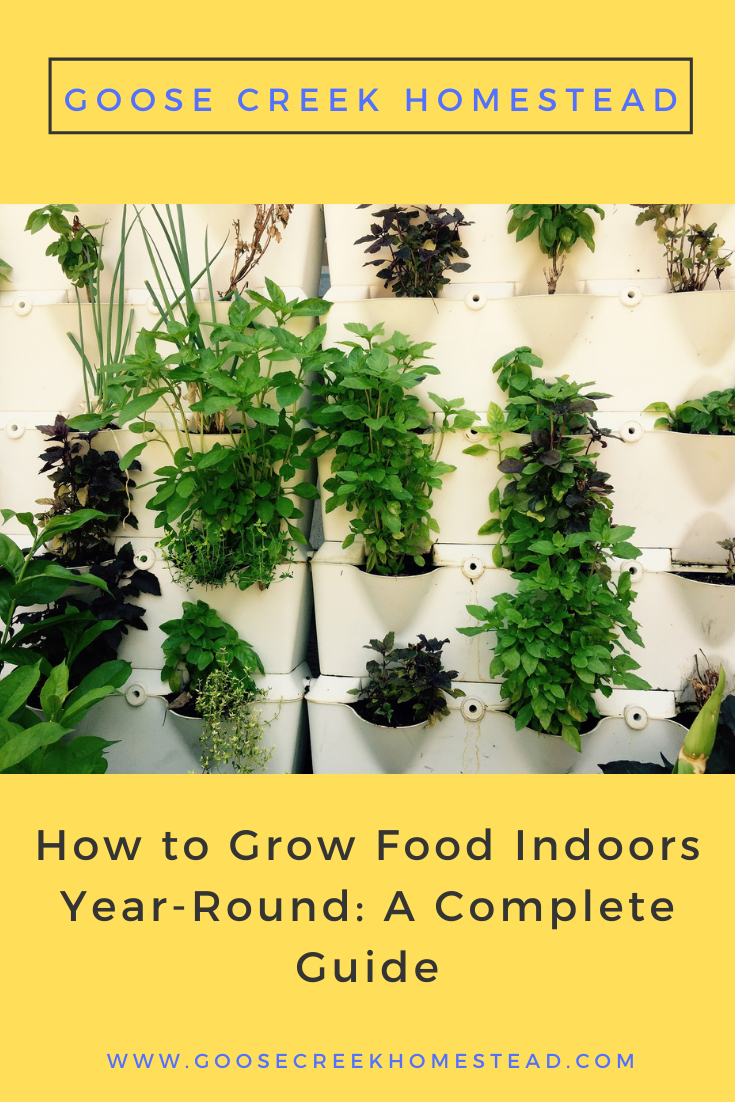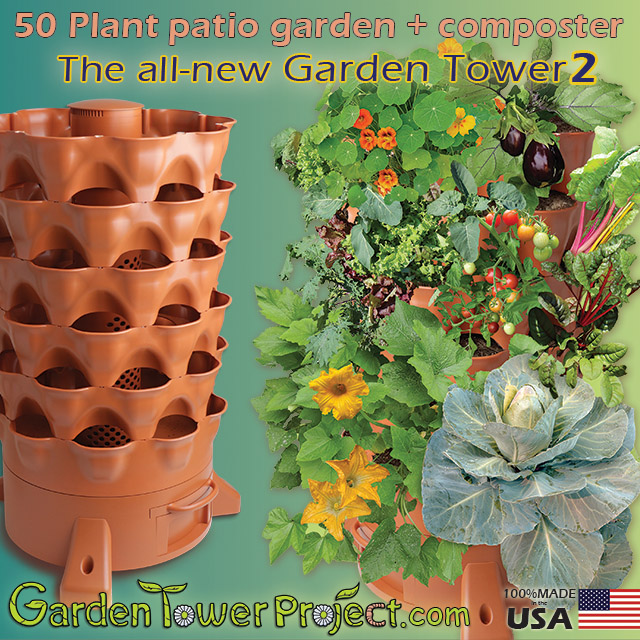Can you grow your own food indoors? Absolutely! From herbs and leafy greens to vegetables and fruit, here’s how to grow food indoors all year long, even if you don’t have much space.
Would you like to supplement your family’s diet with homegrown, fresh food year-round? You absolutely can grow herbs indoors on your windowsill or vegetables and leafy greens in your living room! You just have to find ways to mimic the plants’ ideal growing environment indoors.
In this complete guide to indoor gardening, you’ll find detailed instructions on how to grow food indoors year-round. There’s a lot to cover, so let’s dive right in!
Don’t miss these related articles:
10+ DIY Indoor Garden Ideas for Small and Large Spaces
10 Best Indoor Garden Systems for Herbs and Vegetables

How to Grow Food Indoors: The Pros and Cons
Growing food indoors allows you to control every aspect of the plant’s growing environment for maximum production, nutrition, and flavor. You have complete control over everything from soil quality and nutrients to water, light, and temperature.
That means you can grow food indoors year-round without any environmental pressure!
Indoor food gardens are much easier to maintain than outdoor gardens, too. There’s no weeding or no tilling, and minimal pest and disease pressure. Indoor growing systems can be set up at waist height, so you don’t have to bend over while you tend your plants, which is much easier on your back.
However, there are some cons to gardening indoors that you’ll want to be aware of before you get started. Lack of light and pollinating insects are two of the biggest obstacles to overcome. Airflow and circulation are also vital for the health of your plants, so you’ll need to incorporate some sort of ventilation system into your indoor gardening plans.
And no matter how controlled your environment is, there will always be some pests and diseases that manage to find your plants. You’ll need to learn how to get these issues under control quickly before they take over your indoor garden.
But don’t worry! We’re going to tell you how to overcome these issues!
Food Plants to Grow Indoors
There are so many food plants to grow indoors year-round! Here are just a few of the possibilities!
The Best Vegetables to Grow Indoors:
When choosing which vegetables to grow indoors, look for dwarf, patio, or bush varieties that stay small and do well in containers. Or grow climbing varieties and add trellises behind your containers to make use of vertical space. And don’t forget about hanging planters- they’re perfect for everything from leafy greens to small tomato varieties.
- Microgreens
- Leaf lettuce
- Leafy greens like kale, arugula, mustard, chard, and spinach
- Root vegetables like radishes, beets, carrots, and turnips
- Green onions
- Green beans and peas
- Tomatoes
- Peppers
- Cucumbers
- Dwarf or bush varieties of summer squash
The Best Herbs to Grow Indoors:
Just about any type of herb can be grown indoors.
- Parsley
- Cilantro
- Chives
- Rosemary
- Thyme
- Sage
- Basil
- Ginger
- Garlic
- Chamomile
- Mint

 The Best Fruits to Grow Indoors:
The Best Fruits to Grow Indoors:
While you’re probably not going to be growing a full-sized tree in your living room, many fruits will grow well indoors.
- Strawberries (great for vertical planters and hanging baskets)
- Bush melons (if you have space)
- Dwarf fruit trees, such as Meyer lemon, bananas, and figs
- Bush fruits such as blueberries and raspberries
This is by no means an exhaustive list of food you can grow indoors! If you can grow it outside, it will probably grow inside, if you can provide enough space and the right growing environment.
However, when you’re growing food indoors, efficiency is key for maximizing your harvest. The fastest-growing indoor food plants are microgreens, leaf lettuce, and leafy greens. They’re also the easiest vegetables to grow for beginners.
Food plants that produce multiple harvests over a few weeks or months, like herbs and patio tomatoes, are better suited for indoor growing.
On the other hand, plants that take a very long time to grow and only provide a single harvest, such as cabbage or corn, probably aren’t the most efficient use of your indoor growing space.
Don’t miss these related articles:
10+ DIY Indoor Garden Ideas for Small and Large Spaces
10 Best Indoor Garden Systems for Herbs and Vegetables

How to Grow Food Indoors: Indoor Gardening Requirements
Here’s everything you need to grow food indoors:
· Light
The first thing you’ll need to think about when you’re planning your indoor garden is how you’re going to provide enough light for your plants to grow and thrive. Growing food indoors with lights requires some planning and research, depending on which food plants you want to grow, but it’s not difficult.
Most indoor food plants require around six to eight hours of light each day. If you’ve got a sunny window with good exposure, that may be all you need for many herbs and leafy greens.
If you can’t provide enough natural sunlight for your indoor plants, you’ll need to incorporate supplemental lighting into your indoor growing space. Regular shop lights like these are affordable, and they’re all you need for non-fruiting plants like root vegetables, greens, and herbs.
For fruiting plants like tomatoes, cucumbers, peppers, strawberries, or a lemon tree, you’ll need to invest in full-spectrum grow lights to ensure that your plants are getting enough light to produce a good harvest. You can use a timer to turn the lights on and off as needed.
 |
VIVOSUN 300W LED Grow Light Full Spectrum – $89.99
VIVOSUN 300W LED Grow Light Full Spectrum |
· Growing Medium
The best growing medium for an indoor container garden is a high-quality potting soil mix with good drainage. Or, if you decide to utilize a hydroponic system for indoor growing, choose a lightweight growing medium like perlite or clay balls.
· Containers
When choosing containers for your indoor garden, make sure they have good drainage. Soggy, wet soil leads to rot and disease. You want your soil to be moist, but not wet.
The size of the container you choose also requires careful consideration, depending on the type of plants you intend to grow in it. This can vary greatly from plant to plant so do some research to determine how much space the plants you intend to grow need.
Often, this information is listed on the back of the seed packet or on the plant tag at the nursery. In general, leafy greens and many herbs will do fine in smaller pots while larger plants like peppers, cucumbers, and tomatoes will require more space for their roots to spread out.

· Support
One of the best ways to make use of your indoor space is to grow vertically. Adding support for vining plants like tomatoes, cucumbers, beans, and peas to your growing space allows you to grow up as well as out.
Things like tomato cages, stakes, and trellis netting can all work well here, depending on your setup and what types of plants you’re growing. While I’m not a big fan of tomato cages for full-sized tomatoes in an outdoor garden, they can be fantastic for supporting plants in an indoor garden, especially bush or container tomato varieties and peppers.
· Water
Learning when to water your indoor garden may take some practice, but it’s not super complicated. Most plants do best if the soil is kept moist, never wet or completely dried out. However, certain herbs like rosemary and thyme do prefer drier soils. A little research on your specific plants will be super helpful for getting it just right.
When it comes to getting the water to your plants, an indoor watering can is all you really need. That said, if you have access to a hose and spigot near your growing space, an automated drip irrigation system made for container gardens can be super convenient.
Drip waterers that attach to two-liter bottles are also fantastic for easy indoor gardening. I use them when we’re going away for a few days, so I don’t have to pay someone to come and water my plants.
· Air Circulation
Air circulation is vital to the health of your indoor plants. It will help prevent disease and ensure that your young plants develop nice strong stems. If your growing space has windows, open them whenever the temps are right and let the natural breeze blow through. A fan blowing gently on your plants will also do the job nicely.
· Temperature and Humidity
In general, leafy greens prefer temperatures in the mid-60s to low 70s. Fruiting plants like tomatoes and peppers prefer the upper 70s to low 80s. Most herbs will do fine when temps are in the 70s, although many herbs will thrive at temps above 80 degrees.
If the temperatures in your growing space aren’t suitable for the plants you intend to grow, you’ll need to find ways to control the temperature. Opening windows and turning on fans might be enough to regulate temperatures at certain times of the year, but you might need to experiment with ways to add supplemental heating or cooling in very cold or hot weather.
When it comes to humidity, simply watering your plants should be enough to add moisture to the air. But if you live in an extremely dry climate, you might find that your plants do better if they’re misted with a spray bottle from time to time.
A small tiered greenhouse or grow tent can be fantastic for growing food indoors because you can provide a controlled environment for your plants without affecting the temperature and humidity in the rest of your house.

· Fertilizer
Fertilizer is crucial for indoor gardening because plants that are grown in containers only have access to the nutrients within their containers. Vital nutrients can be depleted over time, so replenishing them is essential.
You’ll want to add a slow-release, organic, vegetable, and herb fertilizer to your soil at planting time. This will release nutrients to the plant gradually over several months. You should also apply liquid fertilizer to fruits and vegetables every seven to 14 days.
If you are growing food indoors using a hydroponic system, choose a high-quality hydropic fertilizer and add it to your system as directed by the manufacturer.
Succession Planting for a Continuous Indoor Harvest
Succession planting is key for a continuous indoor harvest. For plants like lettuce and other leafy greens, you’ll want to start new seeds every few weeks so that you can replace older plants with new, young plants when they stop producing.
Annual herbs, tomatoes, peppers, and similar vegetables will produce food for months before the plants need to be replaced. The length of harvest can vary greatly from one variety to the next, and some may even continue to produce for years if conditions are right. When you notice production tapering off, you’ll know it’s time to replace the plants with new ones.
Perennial plants, such as strawberries and many herbs can continue to grow and thrive for years, so they shouldn’t need to be replaced unless they fail to thrive for some reason.

How to Hand Pollinate Your Indoor Garden
Leafy greens and herbs don’t require pollination, but if you want to grow vegetables like tomatoes, peppers, and cucumbers indoors, you will need to take steps to ensure that the flowers are pollinated. When plants are grown outside, they are pollinated by wind and insects, so you’ll need to mimic these conditions indoors.
The first step to ensuring good pollination in your indoor garden is airflow. When the outdoor temps allow, open all the doors and windows in your growing area, or you can keep a fan blowing gently on your plants during the day.
At least once a day, you should also walk through your indoor growing space and give your fruiting plants a gentle shake to encourage the pollen to fall and distribute throughout the flowers.
I also recommend hand-pollinating the flowers every few days to ensure maximum production. Simply take a small paintbrush and rub it back and forth gently on each flower of your plant, moving from flower to flower until they’ve all been pollinated. This encourages the pollen distribution to the female portion of the flower and will dramatically improve production.
Once the flower wilts and fruiting begins, you’ll know the flower has been pollinated successfully and you no longer need to hand pollinate.
Don’t miss these related articles:
10+ DIY Indoor Garden Ideas for Small and Large Spaces
10 Best Indoor Garden Systems for Herbs and Vegetables
How to Minimize Disease in Your Indoor Garden
When it comes to controlling disease in your indoor garden, good air circulation is vital. Don’t overcrowd your plants because that can restrict airflow and cause rot or fungus issues. And be sure to open the windows or keep a fan blowing gently on your plants for several hours a day.
Overwatering and poor drainage can also lead to disease issues for your plants. Remember that the soil should be moist, but never wet unless you’ve just watered.
If there’s standing water in your pots, they need more holes for drainage, or the growing medium isn’t allowing the water to drain and should be replaced.

Controlling Pests in Your Indoor Food Garden
Some of the most common pests you might find on indoor plants include:
- Common brown scale
- Mealybugs
- Aphids
- Whiteflies
- Red spider mites
- Fungus gnats
- Thrips
The best way to control insects in your indoor garden is to not bring them into your home in the first place. Inspect plants carefully before you purchase them and don’t buy them if they show any signs of pests.
When you bring home a new plant, isolate it from your other plants for at least a few days or even a week. Inspect it daily for signs of pests before adding it to your indoor growing space.
Always clean your pots carefully with hot soapy water between each use and use new or sterilized soil every time. And finally, try not to let your plants’ leaves touch each other. This makes it more difficult for some pests to travel from plant to plant.
If insects do find their way into your indoor food garden, try to isolate the infested plant or plants until the pests are eliminated. You could move the plant to your garage or porch or cover it carefully with a plastic bag during treatment.
Here are some organic pest control methods that can be used to control pests in your indoor food garden:
- BT (for caterpillars)
- Insecticidal soap (for aphids, mites, and other common pests)
- Diatomaceous earth (for general pest control and prevention)
- Green lacewings, ladybugs, and other beneficial insects
Where can you grow an indoor garden?
There are lots of places to grow an indoor garden, from small spaces like a windowsill to larger ones like your garage. The possibilities are truly endless:
- Sunny Windowsill
- Vertically in Front of a Sunny Window
- Closet
- Spare Bedroom
- Grow Tent Tucked into the Corner of Any Room
- Garage
- Basement
- Shipping Container or Utility Trailer
- Shed or Outbuilding
- Storage Unit
- Rented Warehouse
- Greenhouse
Don’t miss these related articles:
10+ DIY Indoor Garden Ideas for Small and Large Spaces
10 Best Indoor Garden Systems for Herbs and Vegetables
When is the best time of year to start an indoor garden?
One of the best things about growing food indoors is that you can start an indoor garden any time of year! You don’t have to wait for temperatures to be just right because you have complete control over the growing environment. You can grow vegetables indoors in the winter and harvest fresh food year-round!
The Bottom Line: You Can Grow Food Indoors Any Time of Year
Why not put your green thumb to work by growing your own vegetables, herbs, and fruit indoors all year long. Indoor food gardens are accessible and easy to maintain, making them a great option for busy lifestyles or anyone with physical limitations. But even more than that, growing your own food indoors allows you to add nutritious, fresh food to your family’s diet no matter what the weather is like outside.



